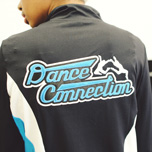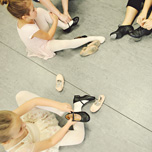Selecting A Dance School
Things to look for when selecting a dance school
It's easy to get confused when most schools offer a qualified teaching staff and a year-end performance. How do you know what to look for? Does it really matter where you decide to enroll? Not all dance schools are equal. Here is a guideline to finding the right school for you.
1. How long has the prospective school been established?
When you begin your search for a dance school, check to see how long a school has been operating in the area. For a dance school to remain established for many years, families have to believe in its philosophies, teaching staff and quality of education. If a school has been in business for many years, they should also have dancers that have studied with them for many years - potentially from pre-school age through graduation. You want a facility that can continue to train your child as he or she advances in study.
2. Does the prospective school have a qualified teaching staff?
A dance school should be able to provide you with a biography or list of credentials for all members of its teaching staff. When you're reading through this information, look for things like memberships to reputable dance organizations (i.e. Dance Educators of America), special awards received in areas of dance and education, years of study, training, performances and other work in the arts. Your child's teacher should be well-trained in the subject area he or she is teaching. The teacher should be a positive force in the classroom, providing an atmosphere of fun, learning and discipline. If a school provides a student teacher, make sure that the student continues to study dance at your school. Check to see if your prospective school offers a teacher training program or an assistant program for its advanced students. Your student teacher needs to have participated in these programs.
3. What skill levels are offered at the prospective school?
A dance school should have enrollment that supports multiple levels of dance for all ages. A strong program will be able to have classes broken out for beginners through advanced. It is imperative that students learn with other students that are approximately the same age. This supports self-esteem and confidence during the learning process. Check to see if the prospective school has separate programs for young students. For example, Dance Connection breaks it's toddlers into three groups: Lil' Steppers (18 months - 2 years), Next Step (3 years) and Combo (4-5 years). Class lengths should be appropriate for the age of the dancer, and class should be structured for their specific learning styles. Children learn very differently during each of these development stages.
4. What is the average class size at the prospective school?
Be sure to ask how many students are enrolled in the class you are interested in. Smaller class size equals more one-on-one attention. By studying in a group environment, children are able to develop relationships, learn to take turns and respect others. On the average, Dance Connection's class sizes are between 10 to 15 for beginner through advanced classes and 6 to 12 for toddler classes. Depending on the class, it is not unlikely to see a classroom assistant aiding the class instructor. Our smaller class sizes promote a strong learning environment, ensuring that an instructor can better view dancer technique and maintain control over behavior and discipline in the classroom.
5. Did the advanced dancers receive their training at the prospective school?
When checking out your prospective school, you may want to view some of their advanced dancers. This is a good indication of what you can expect should your child continue to study at this school. However, it is important to ask if the dancers you are viewing received all of their training at the prospective school. Ethical schools do not make it a practice to try to persuade advanced dancers from other schools to study with them. It can happen, so be sure that the training you see is what you can actually expect to receive.
6. What type of dance floor will you find in the classrooms of the prospective school?
Due to the physical nature of dance, make sure that the prospective school offers a safe surface for dancers. Stress can be applied to bones and joints with repeated jumping and wearing of shoes that do not provide any cushioning or support. A floating dance floor is your best bet. This type of dance floor rests on a system of high-density foam, which absorbs the shock of jumping. This is superior to a sprung floor, which is typically a wood structure built on the regular floor. The top layer of floor is also important, as it should allow dancers to slide, yet control the amount of slipping. This type of top layer, known as a vinyl composite "Marley" floor, is accepted worldwide as the best surface for recreational to professional dance. It can be found in the Royal Winnipeg Ballet, the Royal Academy of Dance in London, England and Riverdance - The Touring Show. It is rare to find this in a school, as it is a very expensive alternative. Dance Connection provides a floating floor in all classrooms. The Professional StageStep TimeStep flooring is a resilient floating wood subfloor that comes 2 ¾" off the slab, offering more absorbency and less resiliency for safety. It consists of two layers of ½" plywood resting on 2" resilient foam cubed blocks. There are 100 blocks per 4' x 8' plywood sheet.
7. Does the prospective school provide a recital for all students?
What kind of "extra" expenses should I expect? Aren't all recitals the same? A recital performance is a great experience for all dancers. Besides creating lifelong memories, a professional recital can give dancers the opportunity to be in a "real" show. Try to find a school that views recital as a professional show in an auditorium setting. Many schools use props, wear costumes and even have show themes. Some schools go to the extent of professionally editing music for classes. Recital expenses can get high. Look for a school that keeps costs to a minimum. Schools do have to pay for facility rentals, lighting, props, etc., so a recital fee is common. Sometimes minimal ticket fees are also in place. Some schools charge a standard costume fee, regardless of what the actual costume costs. Ask upfront what you can expect during this time of year. If you can attend the prospective school's dance recital before enrolling, you should. You can tell so much about a school in the quality of its annual production. Observe the performers. A teacher shouldn't be on the stage with the students after 3 years old, and even 4-5 year olds are capable of performing a routine without having to watch the teacher dance in the wings. Dancers should be developing performance technique (i.e. personality and presence), as well as using proper dance skills.
8. Is there customer service available for me during operating hours at the prospective school?
Not all schools can provide immediate assistance by staffing an office. It is a nice feature if a school does have someone available to answer questions, discuss schedules and take payments. If you can find this in a school, this is a strong indication that customer service and customer satisfaction is important.







